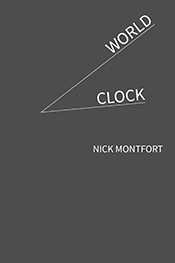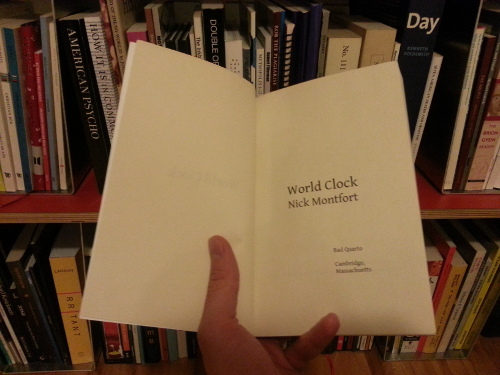From p01 comes a 64 byte JavaScript program to produce a random-seeming maze, as long as the person at the computer is willing to wiggle the mouse a bit. It’s on pouet.net, with comments, too.
World Clock in Print & for Sale
My novel World Clock, generated by 165 lines of Python code that I wrote in a few hours on November 27, 2013, is now available in print.
>_World Clock_ tells of 1440 incidents that take place around the world at each minute of a day. The novel was inspired by Stanislaw Lem’s “One Human Minute” and Harry Mathews’s “The Chronogram for 1998.” It celebrates the industrial concept of time and certain types of vigorous banality which are shared by all people throughout the world.
The code has been online, along with a PDF of the book’s text, since late November. The Python program that generated this novel is available under a free software license. Anyone may make whatever use of it; generate your own novel with the unchanged code, if you like, or modify it to produce something different, for instance.
The book _World Clock_ is for sale to local and remote customers from my local independent bookstore, the Harvard Book Store. (No direct relationship to the university of the same name; they both happen to be located in Harvard Square.) The book is printed on the Espresso Book Machine in the store – to the amazement of onlookers. The apparatus has been dubbed “Paige M. Gutenborg.”
The 239-page paperback can be purchased for only $14.40, which is the low, low price of only one cent per minute.
European Poetry Forum is up
The new project European Poetry Forum by Zuzana Husarova Martin Solotruk is now online.
The project aims to connect a diverse group of poets with overlapping interests, as this statement about it explains. There are answers to queries from 38 poets up now.
No Code: Null Programs
Just posted: **TROPE-13-03 – No Code: Null Programs** by Nick Montfort, in the Trope Report series (technical reports from my lab the Trope Tank at MIT).
>To continue the productive discussion of uninscribed artworks in Craig Dworkin’s _No Medium,_ this report discusses, in detail, those computer programs that have no code, and are thus empty or null. Several specific examples that have been offered in different contexts (the demoscene, obfuscated coding, a programming challenge, etc.) are analyzed. The concept of a null program is discussed with reference to null strings and files. This limit case of computing shows that both technical and cultural means of analysis are important to a complete understanding of programs – even in the unusual case that they lack code.
Please share and enjoy. And do feel free to leave a comment here if anything to add on this topic, or if you have a question about this report. I’d be glad to continue the discussion of these unusual programs.
Skinning Poetry
Online magazine The Claudius App, devoted to “fast poems and negative reviews,” is now in its fifth number and clad in the classic Sim-City-like skin of a burning New York City. There’s a more standard but still DOS-like directory listing, with links to much fine fare, including a translation of a Georges Perec piece and an interactive but also self-scrolling work, “Titanichat,” by Cecilia Corrigan and Ian Hatcher. It comes with a soundtrack, too.
Collect all five numbers, with their curiously strong interfaces: 1,
2,
3,
4,
5.
Apple’s Home Page Today

A great tribute. I’m sure this company wants you to feel Mandela-like while you line their coffers and lock yourself into consumption. This company would of course have you forget that the Nelson Mandela of computing would actually smash a corporate oppressor. Apple, Inc. metaphorically incarcerates mobile phone users, which is why they need to jailbreak their phones. And free speech doesn’t exist in the Apple Store, as it still does on the Internet. Apple, Inc. chooses what you are allowed to say and what computation you are allowed to do, so if you want privacy, no – on the other hand, if you want to be cured of homosexuality, you got it. Not that I object to different and even hateful opinions in a realm where free speech is allowed – but there is no such realm in this iCorporate la-la land.
If you admire Mandela, why not use a system that was developed with the South African/Zimbabwean philosophy of “humanness” or “humanity towards others”? The name for this free/libre/open source operating system, developed for the betterment of people rather then concentration of wealth, comes from Nguni Bantu. It’s a distribution of GNU/Linux, Ubuntu.
The Firewall .. is Us!
Slavoj Žižek did not write a twine game, but Alan DeNiro did. It’s called We Are the Firewall, and it has more rodents than Rat Chaos. It twists and communicates with the whole category of Twine games quite well, and the writing is quite compelling, and it’s well worth reading/solving.
DeNiro, by the way, is the author of (in addition to short stories and novels) the uncanny interactive fiction Deadline Enchanter, which I also recommend.
ELO Conference Deadline on Dec 15
The next Electronic Literature Organization conference, to take place in Milwaukee on June 19-21, has just extended its deadline for submission to December 15. Media Art Show proposals and abstracts for academic talks are both welcome.
Video of Nanowatt Online
A single-loading VIC-20 demo (3583 bytes) presented on November 30, 2013 at Récursion in Montréal. By Nick Montfort, Michael C. Martin, and Patsy Baudoin (nom de nom, mcmartin, baud 1). This video is of the demo running in the Trope Tank at MIT on December 3, 2013.
Tagged on YouTube as Commodore VIC-20, Samuel Beckett, Electronic Literature, Computer (Musical Instrument), and Demoscene. See also the fuller story about Nanowatt with links to executable code.
NaNoGenMo Wraps Up and Prints Out
There are some things I absolutely must mention at this point, to highlight certain of the many interesting outcomes from NaNoGenMo (National Novel Generation Month):
Alice’s Adventures in the Whale, one of two novels created by Leonard Richardson by computationally replacing all the dialog in one novel with the dialog in another:
>Alice was beginning to get very tired of sitting by her sister on the bank, and of having nothing to do: once or twice she had peeped into the book her sister was reading, but it had no pictures or conversations in it, “Can’t sell his head?–What sort of a bamboozingly story is this you are telling me?” thought Alice “Do you pretend to say, landlord, that this harpooneer is actually engaged this blessed Saturday night, or rather Sunday morning, in peddling his head around this town?”
…
>Presently she began again. “Ka-la! Koo-loo!” (she was rather glad there WAS no one listening, this time, as it didn’t sound at all the right word) “Stand up, Tashtego!–give it to him!” (and she tried to curtsey as she spoke–fancy CURTSEYING as you’re falling through the air! Do you think you could manage it?) “Stern all!”
…
>”My God! Mr. Chace, what is the matter?” said poor Alice, and her eyes filled with tears again as she went on, “we have been stove by a whale.” cried Alice, with a sudden burst of tears, “NARRATIVE OF THE SHIPWRECK OF THE WHALE SHIP ESSEX OF NANTUCKET, WHICH WAS ATTACKED AND FINALLY DESTROYED BY A LARGE SPERM WHALE IN THE PACIFIC OCEAN.”
…
>CHAPTER V. Advice from a Caterpillar
>
>The Caterpillar and Alice looked at each other for some time in silence: at last the Caterpillar took the hookah out of its mouth, and addressed her in a languid, sleepy voice.
>
>”I say, pull like god-dam,” said the Caterpillar.
>
>This was not an encouraging opening for a conversation. Alice replied, rather shyly, “There she slides, now! Hurrah for the white-ash breeze! Down with the Yarman! Sail over him!”
Leonard’s other submitted novel used Pride and Prejudice (and Through the Looking Glass). Along similar lines, you may be interested in seeing what Pride and Prejudice looks like without any dialog.
Early in the month, Zarf (Andrew Plotkin) submitted a generated novel that is entirely dialog: Redwreath and Goldstar Have Traveled to Deathsgate.
Ian Renton generated Doctor Who fan fiction using the technique of Bayseian poisoning, which is popular in spam generation. It’s only the only fanficlicious novel; see the generated Austenesque novels of jiko.
I was implicated in inspiring Nif, a palindromic 50,000-word+ novel, the second generated novel submitted (early in the month) by catseye. A remixed and extended version was done by Michael Paulukonis.
Don’t miss Aaron Reed’s Agressive Passive, which details conversation between six housemates about maintaining the cleanliness of their domicile.
And finally, my entry is World Clock, which briefly describes something happening, at some location around the world, at each minute of a day.
The overall “site” for NaNoGenMo, which was the fervent brainchild of Darius Kazemi, is, by the way, this humble GitHub repository.




